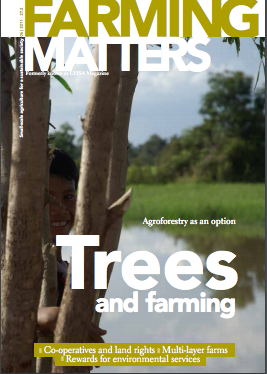Agroforestry is one of mankind’s best hopes to create a climate-smart agriculture, increase food security, alleviate rural poverty and achieve truly sustainable development”, write Dennis Garrity and Paul Stapleton in the theme overview for this issue.
Agroforestry can produce impressive results, as several experiences confirm. In a recent (must-read) report, Olivier de Schutter, Special Rapporteur to the UN on the Right to Food, refers to agroforestry successes in Africa. He convincingly argues that a farming system that integrates annual crops, trees and animals, is a highly effective way of dealing with the challenges facing farmers today.
So it is good to see that the number of trees on farms is increasing. Farmers are more motivated to grow trees. An impressive example can be seen in Niger, where the number of trees on farms has increased by 200 million in 30 years, covering a total area of 5 million hectares. Similarly impressive are the tree-growing initiatives of marginal farmers and landless women and men in Bangladesh, who, over the past twenty years have planted hundreds of millions of trees on their homesteads, on farm land and along roadsides.
Yet one thing is crucial in these two and in all other cases: smallscale farmers and landless people will only plant and tend trees if their rights to use these trees are secure. And a lack of rights is not the only possible threat to such “regreening”. The recent surge in large-scale commercial investments in land is leading to a further marginalisation of small-scale farmers and their loss of rights to land and trees. In pursuit of “efficiency”, large-scale mechanised farms can turn vast stretches of land into ecological deserts, with not a tree to be seen.
A recent (and also a must-read) report by OXFAM argues for greater complementarity between large-scale industrialised farming and small-scale, low external input farming. Can we envisage a future where large and industrialised farms embrace agro-ecological principles, and small farmers share the responsibility of regreening the environment – and share the benefits?
Text: Edith van Walsum, director ILEIA

